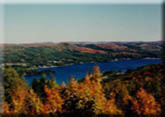

|
|
|
CLEAN AIR Air pollution affects the health of all Canadians, especially children, the elderly and those with respiratory and cardiac conditions. Toronto Public Health Department figures show that air pollution causes 1,000 deaths a year and numerous health-related problems. Federal studies show there are 5,000 deaths a year that can be attributed to air pollution, and the Ontario Medical Association says air pollution costs Ontario citizens more than $1 billion a year in hospital admissions, emergency room visits and absenteeism. While there has been progress on clean air, the growth of air pollution sources has the potential to outstrip gains. What is Smog? Smog refers to a noxious mixture of air pollutants such as nitrogen oxides, ground-level ozone and fine particles. This mixture can often be seen as a brownish-yellow or greyish white haze, mainly in our big cities. While ground-level ozone forms during hot and sunny summer days, other pollutants can be present in the atmosphere year-round. As a result, scientists and medical experts now agree that air quality can be a year-round problem. It is also believed that there is no safe level for exposure to smog. Two key components of smog are airborne particulate matter and ground-level ozone. Particulate Matter: Airborne particulate matter, also known as PM, is composed of minute solid or liquid particles small enough to remain suspended in the air. These particles give smog its brown, dark grey, or white colour. Numerous studies have linked PM to aggravated heart and lung diseases such as asthma, bronchitis and emphysema. Across Canada, non-industrial fuel combustion, such as wood smoke, contributes to 77 per cent of PM. Ground-level Ozone is a colorless and highly irritating gas that forms in the atmosphere when sunlight "cooks" air pollutants often found over urban areas on hot summer days. Ozone is called a "secondary" pollutant because it is produced when two "primary" pollutants, nitrogen oxides and volatile organic compounds, react in sunlight and stagnant air. Near the ground, ozone is a serious pollutant. Smog is not the only air pollution issue:
Persistent Organic Pollutants (POPs): these are industrial chemicals such as PCBs, pesticides such as DDT, chlordane and toxaphene, and contaminants and by-products such as dioxins and furans. POPs bioaccumulate in living organisms, persist in the environment and have long-term toxic effects. POPs can move through the food chain to humans, and can be passed from mother to child across the placenta and through breast milk.
Atmospheric environmental issues that are related to clean air also include climate change and ozone layer depletion. Many of the actions we take for cleaner air also have a benefit in addressing climate change, particularly those with transportation and energy production. As well, scientists are beginning to understand more about the relationship between ground-level ozone (the "bad" ozone) and the ozone layer (the "good" ozone).
|

